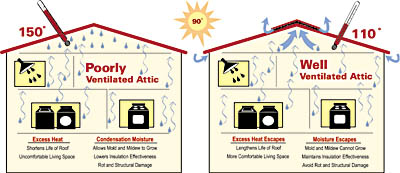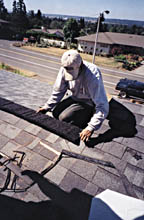Effective Attic Ventilation: Just What the Doctor Ordered
The key to protecting the health of residents is to minimize the occurrence of mold and mildew from the start. One important prevention method lies squarely with the roofing contractor: the proper installation of appropriate attic ventilation.
Sick Building Syndrome
There have been reports of cases in which exposure to mold and mildew has led to violent bronchial attacks, chronic sinus infections, central nervous system problems and even memory loss.According to cec-consultants.com, the Web site of an industrial engineering consulting firm, biological contaminants also have been linked to Sick Building Syndrome. Building occupants in a “sick building” may develop health conditions that appear to be linked to time spent in the building. Research indicates that symptoms disappear when the person leaves the building. Although no specific cause of symptoms has been identified, mold and mildew have been named as one possible factor.
Lawsuits resulting from SBS claims in California and Chicago cite roof leakage and moisture as causes of mold growth. Also cited in the SBS claims is the belief that inadequate ventilation is a primary factor enabling mold and mildew growth. A World Health Organization Committee report estimates that up to 30 percent of new and/or remodeled buildings have unusually high rates of SBS complaints.
The challenge for contractors is that buildings typically possess all elements necessary for mold growth: mold spores, a sufficient nutrient base, a temperature of 40 to 100 degrees F and the presence of moisture.
When homeowners report mold damage to their insurance company, the company investigates the cause to determine if the damage is covered by the holder’s policy. If the cause of mold is determined to be flawed workmanship or materials, then this cause in fact points to the contractor, who is now forced to defend this claim — often without insurance coverage. Recently, some insurance companies have stopped covering mold-related damage in several states and contractors face severe liabilities.
According to Steve Slepcevic of Paramount Disaster Recovery Services, “Mold growth is a huge issue in California and spreading throughout the U.S. Contractors are being held responsible if they are in any way involved with water leaks, inadequate ventilation or poor material application. If there is an area of water intrusion or roof leak, there is a good chance that mold will result if not treated within 48 hours. That is why it needs to be addressed immediately, using proper drying equipment and chemicals. Once the presence of mold and mildew is established, it needs to be handled by a mold abatement professional, because when the mold is disturbed it can become airborne and contaminate the adjoining areas of the property.”

Attic Ventilation
An effective attic ventilation system can prevent moisture and control humidity, thereby minimizing mold and mildew growth. Inadequate ventilation is the cause of about 50 percent of indoor air pollution and may also cause shingles to deteriorate twice as fast. Shingles installed with improper ventilation may result in voiding the manufacturer’s warranties.An attic can easily reach temperatures of 150 to 160 degrees F. Cooling requirements for the home are raised dramatically in warmer months. The rate of moisture condensation increases when warm, moist air is trapped in the attic and comes in contact with cool air and building materials in colder weather.
An article by B.R. Stewart, “Attic Ventilation for Homes,” which he published as an agricultural engineer, environmental control, at the Agricultural Extension service of Texas A&M University, further explains. “Ventilation of the home attic is important for two reasons,” he says. “During the summer, excess heat that builds up in the attic during the day results in high-energy costs for cooling. Also, moisture produced within the home may move into the attic if ceiling vapor barriers are not used. If this moisture is not exhausted from the attic, it can condense and cause insulation and construction materials to deteriorate. Thus, temperature and moisture control are the major reasons for providing attic ventilation.”
Though today’s homes are sealed more effectively from weather intrusion, moisture will still enter the home no matter how tightly sealed. A typical family can generate 2 to 4 gallons of moisture per day through routine activities such as cooking, bathing and laundry. Other daily moisture causes in the home can include flooding, leaking pipes, damp basements, and/or leaky roofs.
But moisture can also be present in buildings in its gaseous state, commonly referred to as humidity. At a 70-percent humidity level, the growth of fungi is rapid. Unfortunately, relative humidity often exceeds 70 percent indoors even when attic ventilation requirements are met. This problem is prevalent in humid climates where the outdoor relative humidity value commonly exceeds 70 percent. By controlling the indoor relative humidity between 30 and 50 percent, biological growth can be minimized.

What to Do
The question then becomes “What is the best way to ventilate the attic?” There simply is not one way that is “the best” but contractors must consider which type of ventilation will work in their individual circumstances. There are two types of ventilation: dynamic and static.Power, or dynamic, ventilation is accomplished in two ways. According to Stewart, in homes not mechanically cooled (air-conditioned) the temperature can be controlled to some extent by the use of attic fans. These fans are usually ceiling mounted in a central hallway so that outside air is pulled through open windows and exhausted through the attic. Sufficient outlets should be installed through the attic uniformly. Again it is important to calculate the required amount and position of vents to adequately ventilate the attic.
Keep in mind, however, that power ventilation methods can add to the energy use of the home. And according to askthebuilder.com, “It turns out that rooftop- and sidewall-mounted attic fans can actually suck air conditioned air from your house into your attic space.”
Another option is static ventilation, which is the use of non-powered ventilation products that work with the natural flow of warm air and wind movement around the home. This method takes advantage of two principles. First, as air is heated it becomes less dense and rises. Second, wind movement over and around a home creates areas of high and low pressure. If a space has high air outlets (exhaust) in conjunction with low inlets (intake), ventilation occurs as the air within the space is heated.
Continuous ridge ventilation combined with soffit vents is the most common form of static ventilation. It provides for a total movement of air throughout the attic space. Other forms of static systems include gable vents installed at the attic wall, and turbine vents and pot vents installed near the peak of the roof that work by drawing air from the attic space.
One manufacturer of continuous ridge vents with years of experience in the air filter industry is Blocksom & Co., maker of Roof Saver ridge vents. “While developing Roof Saver, our research department found that a system consisting of continuous ridge vents combined with soffit vents provides thorough ventilation of the attic, including air spaces that often hold stagnant air when other types of ventilation are used,” remarked Andy Swan, president of Blocksom & Co. “Continuous ridge vents combined with soffit ventilation allow outside air to flow into the entire attic and displace super-heated and moist air. Air is always able to exit the attic and exhaust contaminants from the home.” Concludes Swan, “It is critical that all types of attic ventilation be designed and installed properly to prevent biological growth, especially mold and mildew.”
Looking for a reprint of this article?
From high-res PDFs to custom plaques, order your copy today!



